Nine-Note Double Seed Stitch Blanket
Like a flash of light, our Nine-Note Double Seed Stitch Blanket starts with a pale burst at the center and flows into rich shadow by the outer edge. In a dauntless display of subtle value shifts, yarn reminds us, once again, just how much we love it!

The yarn here is our Nine-Note Bundle, a gently gradating series of nine skeins of 80% extra fine merino and 20% baby alpaca. Incredibly soft and wonderfully squishy, it knits up one heck of a cuddly blanket.

Part of the fun is that you start this blanket at the center, then work it in the round, increasing at the corners until you bind off around the perimeter. You finish by whip stitching the cast-on edge closed and wowza, a window onto a sunlit world!

One Nine-Note Bundle makes a Crib size for lucky babies, while two or three bundles make Small or Large Throw sizes for lucky adults. Choose from four palettes. We used pretty Rosebud and punchy Hyacinth, but wild Mulberry and soothing Tidewater are equally tempting!
Yarn lovers, if you adore the yarn used in this project, you’ll love exploring all of our other yarn collections! Discover over 45 thoughtfully designed yarns in nearly every natural fiber and in every spectacular color you can imagine. Only available here at Purl Soho’s online yarn store, where every skein is created with care and your creativity in mind!


Designed by Purl Soho designer, Jake Canton. Click here to see even more of Jake’s designs!
Share your progress and connect with the community by tagging your pics with #PurlSoho, #PurlSohoBusyHands, #PurlSohoNineNoteDoubleSeedStitchBlanket and #PurlSohoNineNoteBundle. We can’t wait to see what you make!
Materials

1 (2, 3) of Purl Soho’s Nine-Note Bundle(s). One bundle includes…
- 9 skeins of 80% extra fine merino wool and 20% baby alpaca yarn. Each bundle is approximately 900 yards/ 450 grams; approximately 860 (1620, 2580) total yards required. We used the colors Hyacinth and Rosebud for our samples. (NOTE: We no longer offer the Hyacinth and Rosebud bundles.)
You will need either…
- An interchangeable needle set with multiple cord lengths
Or…
- US 5 (3.75mm), 16-, 32-, and 60-inch circular needles
- Optional: A spare needle 1–2 sizes larger for the bind off
You will also need…
- A set of US 5 double pointed needles
- 4 stitch markers, including one unique
Gauge
18 stitches and 36 rounds = 4 inches in Double Seed Stitch in the round (see Notes)
Note: We designed these blankets to use as much of the skeins as possible, so achieving this gauge is critical. To avoid running out of yarn, check your gauge, be sparing with your tails, swatch using the darkest color (Color I), and reuse your swatch yarn, if necessary. If gauge is a new concept for you, our All About Gauge tutorial is a helpful primer!
Sizes
Crib (Small Throw, Large Throw)
Finished Dimensions: Approximately 30 (41½, 53) inches wide x 32¾ (44¼, 55¾) inches long
Samples: The Hyacinth sample is the Crib size, and the Rosebud sample is the Large Throw size.
Notes
CONSTRUCTION + NEEDLES
You will knit this blanket in the round, starting in the center and increasing at each corner until you bind off around the entire perimeter. You will cast onto a set of double pointed needles and then switch to increasingly longer circular needles as the number of stitches grows.
COLORS A–I
The lightest color skein is Color A; the next lightest skein is Color B; the next lightest skein is Color C, and so on to the darkest color skein, Color I.
DOUBLE SEED STITCH (FOR GAUGE SWATCH)
Cast on an odd number of stitches.
Rounds 1 + 2: *K1, p1, repeat from * to last stitch, k1.
Rounds 3 + 4: *P1, k1, repeat from * to last stitch, p1.
Repeat Rounds 1–4 to desired length.
ONE-COLOR ROUNDS
Round 1: [Kfb, *k1, p1, repeat from * to one stitch before next stitch marker, kfb, slip marker (sm)] 4 times. [8 stitches increased]
Round 2: *K1, p1, repeat from * to end of round.
Repeat Rounds 1 and 2 specified number of times.
TWO-COLOR TRANSITION
Round 1: With new color, [kfb, *k1, p1, repeat from * to one stitch before next stitch marker, kfb, sm] 4 times. [8 stitches increased]
Round 2: With old color, *k1, p1, repeat from * to end of round.
Rounds 3 + 4: Repeat Rounds 1 and 2.
PATTERN
BEGIN AT CENTER
With Color A and four double pointed needles, use a basic Long Tail Cast On to cast 10 stitches onto each needle, leaving at least a foot-long tail. [40 total stitches]
Place unique marker and join for working in the round, being careful not to twist the stitches.
Set-Up Round: *[K1, p1] 8 times, place marker (pm), [k1, p1] 2 times, pm, repeat from * to end of round. Note: The final stitch marker is the unique end-of-round marker.
CONTINUE
Continuing with Color A, work Rounds 1 and 2 of One-Color Rounds (see Notes) 19 (27, 34) times. [192 (256, 312) stitches]
Join Color B.
Using Color B as the new color and Color A as the old color, work Rounds 1-4 of Two-Color Transition (see Notes) one time. [208 (272, 328) stitches]
Cut Color A.
With Color B, work Rounds 1 and 2 of One-Color Rounds 9 (13, 17) times. [280 (376, 464) stitches]
Join Color C.
Using Color C as new color and Color B as old color, work Rounds 1–4 of Two-Color Transition one time. [296 (392, 480) stitches]
Cut Color B.
With Color C, work Rounds 1 and 2 of One-Color Rounds 6 (9, 12) times. [344 (464, 576) stitches]
Join Color D.
Using Color D as new color and Color C as old color, work Rounds 1–4 of Two-Color Transition one time. [360 (480, 592) stitches]
Cut Color C.
With Color D, work Rounds 1 and 2 of One-Color Rounds 4 (6, 8) times. [392 (528, 656) stitches]
Join Color E.
Using Color E as new color and Color D as old color, work Rounds 1–4 of Two-Color Transition one time. [408 (544, 672) stitches]
Cut Color D.
With Color E, work Rounds 1 and 2 of One-Color Rounds 4 (6, 8) times. [440 (592, 736) stitches]
Join Color F.
Using Color F as new color and Color E as old color, work Rounds 1–4 of Two-Color Transition one time. [456 (608, 752) stitches]
Cut Color E.
With Color F, work Rounds 1 and 2 of One-Color Rounds 3 (5, 7) times. [480 (648, 808) stitches)
Join Color G.
Using Color G as new color and Color F as old color, work Rounds 1–4 of Two-Color Transition one time. [496 (664, 824) stitches]
Cut Color F.
With Color G, work Rounds 1 and 2 of One-Color Rounds 3 (5, 6) times. [520 (704, 872) stitches]
Join Color H.
Using Using Color H as new color and Color G as old color, work Rounds 1 and 2 of Two-Color Transition one time. [528 (712, 880) stitches]
Cut Color G.
With Color H, work Rounds 1 and 2 of One-Color Rounds 2 (4, 6) times. [544 (744, 928) stitches]
Join Color I.
Using Color I as new color and Color H as old color, work Rounds 1 and 2 of Two-Color Transition one time. [552 (752, 936) stitches]
Cut Color H.
With Color I, work Rounds 1 and 2 of One-Color Rounds 1 (2, 5) time(s), then repeat Round 1 one more time. [568 (776, 984) stitches]
With Color I, bind off very loosely in (k1, p1), using a larger needle, if needed.
FINISH
Seam the hole at the center of the blanket closed. Here’s how…
With right side facing you, turn the piece so the opening is oriented horizontally and the cast-on tail is at the right. Align the cast-on edges so the increases meet at the sides. Thread the tail onto a tapestry needle and insert needle from bottom to top through the lower cast-on edge, then from bottom to top through the upper cast-on edge.
Repeat this whip stitch for the remaining cast-on stitches, then thread the tail to the back of the piece to weave in.
Weave in ends and gently wet block to finished dimensions.


Looking for more inspiration? Explore all of our free knitting patterns and knitting tutorials, buy one of our many knitting kits and yarn bundles, and shop for beautiful yarn. We have over 35 gorgeous natural fiber yarns in 100’s of magnificent colors, designed to bring integrity, beauty, and joy to your next knitting project and only available at Purl Soho!



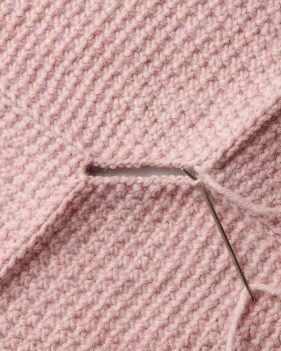
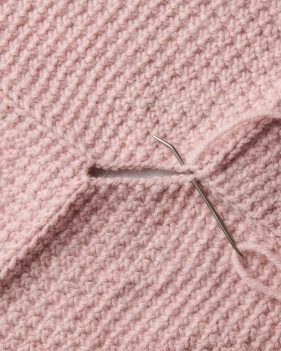
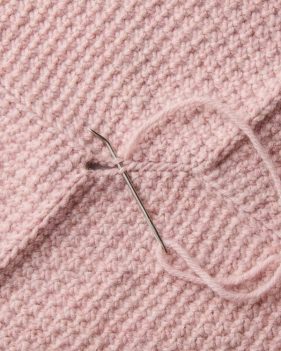



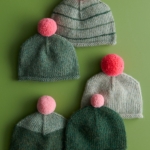
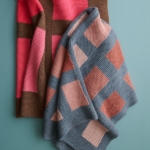
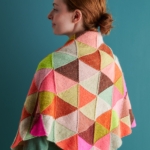
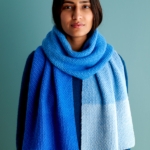
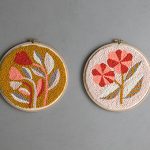

What is the finished size of the large throw please? I’m not seeing it in the description.
Hi Jenn,
Thanks for reaching out. The finished dimensions of the large throw size are 53 inches by 55.75 inches!
All the best,
Lili
I think you could use judy’s magic cast on for the first row to avoid any seaming.
Hi Anna,
Thanks for writing in. I think that using Judy’s Magic Cast-On will indeed work for this pattern! Let us know if you end up trying it and how it goes!
All the best,
Lili
I love the idea of not having to seam at the end, and would like to try Judy’s Magic Cast-On. Where would you be in this pattern after using that? How would you go from the circular needle to the double-pointed needles (and would you need to shift to double-pointed needles at all)?
Hi Erin,
After working Judy’s Magic Cast-On, you can begin right with the Set-Up Round! Or, if you’re worried that the stitches need a bit more securing first, you can knit one round and then work the Set-Up Round.
Since this cast-on requires you to use magic loop, you can continue using your circular needles in magic loop until you’re ready to transfer the stitches to shorter circular needles and work in the round as normal. (You don’t need to switch to DPNs at all, unless you really want to.)
I hope this helps!
All the best,
Lili
I tried this, and it worked very well—no hole in the middle of the blanket to stitch up! I cast on with double-pointed needles, so just continued with the pattern as written.
I love the pattern, but I’m allergic to wool. Can I still use this?
Looks WONDERFUL! I dunno why, but I love making blankets! What are your thoughts about knitting this in garter stitch? I’m slogging my way through a Queen Size Double Seed Stitch blanket, and while I will indeed finish, I’m very glad to have switched the Nature’s Pallet blanket to garter. Would garter make this blanket overly stretchy? Make the color changes too sharp? I’d love to hear your thoughts. Regards – Lisa
Hi Lisa,
Thanks for writing in, and thank you for your kind words. I think this blanket would look really nice in garter stitch–that sounds very cozy! The gradient between the skeins in the Nine-Note Bundle is actually so subtle that I don’t think changing the stitch will make the color changes too sharp at all. I hope this helps, and let us know how it goes if you decide to use garter stitch!
All the best,
Lili
What is the wool you use with this? I don’t see anything in your yarn that’s 80/20 merino / alpaca?
Hi Kelly,
Thanks for reaching out. The yarn we use for this blanket (as well as the Nine-Note Wrap) was developed with these specific projects in mind! So I’m sorry to say that we do not offer it separately.
All the best,
Lili
I’m just wondering about cleaning this, I’m assuming it’s hand wash and lay flat to dry?
Hi Elizabeth,
Thanks for reaching out. You’re absolutely correct! We recommend hand washing the blanket in cold water and laying flat to dry. Hope this helps!
All the best,
Lili
Hi! I ordered a bundle to make the wrap. Can the throw pattern be adapted to also make a wrap? I love the blanket sequencing!
Hi Cynthia,
Thanks for writing in, and I think that’s a great idea to use the blanket pattern to make a wrap! I would modify it by casting on a lot more stitches at the beginning (and making sure to leave a far longer tail!) so that the shape of the resulting fabric is a longer rectangle, closer to the shape of the wrap. You’ll also need to make sure you place some of your markers farther apart during the set-up round. Hope this helps!
All the best,
Lili
Hi Lily,
I want to make a wrap too but had no idea how to go about it. Any idea as to how many stitches to cast on to get it to be 70 inches? I wonder if I need a third bundle for a wrap and how wise it would end up. I think it would be gorgeous but the whole thing is eluding me numbers-wise. I realize you don’t have a pattern for this and understand you may not have advice for me. Thanks in any event!!
Jane
Hi Jane,
No worries, I can help you figure out how to get started! For a 70-inch-long wrap, you will only need 1 bundle, and the wrap will end up being 14 inches wide. You should cast on 252 stitches, using 122 for each long edge and 4 for each short edge. Then, as you knit outwards in the round, increasing at the stitch markers, your wrap will end up 14 inches wide and 70 inches long! The final step, like in the blanket version, would be to seam all the way up the center of the wrap.
All the best,
Lili
Hi Lili
I’m very excited. I bought an extra bundle so I can make it even wider if I want. I was just wondering how to place the stitch markers for the seams if it is 122 on each long end. I hope I like doing it because I also got some bundles in the bright blue (along with the grey figuring I would do a second one)! Do I place the first original marker, them 122 stitches and next marker, then 4 stitches and next marker, then 122 stitches and next marker (and there would be 4 stitches to the main original marker)?
Thanks!
Hi Jane,
Yes, that’s how I would recommend placing the stitch markers! Glad to hear that you’re excited about this project!
All the best,
Lili
Hello,
I am reading through the pattern and wondering when would you switch from the double pointed needles to the circular needles?
Thanks for any insight.
Hi Leslie,
Thanks for writing in. You can switch to circular needles whenever you have enough stitches to comfortably fit around the cord! So if you have a pair of 16″ circulars, you can switch once you have at least 72 stitches (which is equivalent to 16 inches according to the gauge). And as the blanket keeps getting larger, you’ll need to transition to the longer circular needles accordingly. Hope this helps!
All the best,
Lili
Could this be done without the seed stitch for truly mindless knitting? Just knit stitches. I always get bungled up with seed stitch.
Hi Jennifer,
Thanks for writing in. You can definitely make this blanket in stockinette stitch! However, you might experience some curling at the edges, so it may be a good idea to knit a border as you near the edges, so that the blanket can lay flat. You could also knit the entire thing in garter stitch, but to do that in the round, you’ll need to alternate knit rounds and purl rounds. Hope this helps!
All the best,
Lili
I prefer knitting this blanket in stockinette stitch. How big of a knit border would you suggest to keep it from curling?
Hi Jill,
Thank you for your comment. I would suggest knitting enough border rounds to reach at least 2-3 inches, just to be safe. This should help prevent curling, but adding tassels or a crochet border would also work!
I hope this helps!
All the best,
Margaret
How many skeins do I need for the biggest blanket?
Hi Judy,
Thanks for reaching out. You’ll need 3 Nine-Note Bundles to make the Large Throw size of this blanket! This totals to 27 skeins.
All the best,
Lili
I think there may be a typo in the “one-color” and “transition” rounds. Should the repeat be written to include kfb before and after each marker?
Hi Lesley,
Thanks for reaching out. I can confirm that these sections do include instructions to work a kfb before and after each marker! For example, Round 1 of the One-Color Rounds reads:
Round 1: [Kfb, *k1, p1, repeat from * to one stitch before next stitch marker, kfb, slip marker (sm)] 4 times. [8 stitches increased]
The first kfb within the brackets is the one you’ll work directly after slipping a marker, and the second kfb within the brackets is the one you’ll work right before slipping the marker (sm). Then, the instructions say to repeat this 4 times in total, to account for all 4 markers!
I hope this helps clear things up.
All the best,
Lili
For some reason I read the pattern incorrectly too and missed the increases after the sm too. Maybe because of the hyperlink to the kfb instructions?! I knew something had to be wrong because i ended up with ribbing in places 😤😝. Just wanted you to know you are not alone and your comment helped me to see my error!
I bought two Nine-Note Bundles for my daughter for Christmas. I’m knitting the Nine-Note Seed Stitch Wrap in the Mulberry color way and she will knit the Hyacinth. I have already started mine. The yarn is absolutley HEAVENLY!! So soft, and it knits BEAUTIFULLY!!! I just ordered a third bundle, to knit a baby blanket in the Rosebud color way. I HIGHLY recommend this yarn!!!
Hi, Can this beautiful blanket be adapted to a 30 X 40 inch rectangle. Will one bundle be enough?
Also, does the alpaca in the yarn make it shed, i.e linty?
Thanks for your help with this.
Fran
Hi Fran,
Thanks for reaching out! The Crib size (30 inches wide x 32¾ inches long) uses the exact amount of yarn included in the 1 bundle, if you would like to extend the blanket to 40 inches long you may need an additional bundle to ensure you have plenty of yarn to finish! Also, in my experience with the yarn, it doesn’t shed too much, that being said you may find that it does shed a bit while working with it, but once you finish + block the blanket the shedding should be as present.
Warmly,
Gianna
I’m new to using double sided needles. For the cast on and join, will I need to add one additional stitch for the join? That would leave 40 working stitches to begin the set up row. Or do the 40 cast on stiches get reduced to 39 working stitches after the join? Thank you for any clarification you can provide to this novice knitter!
Hi Cindy,
Thanks for reaching out! For the cast on and join, there should be 40 stitches cast on, and when you join the work in the round, it shouldn’t reduce the number of stitches at all. So once you cast on the 40, join the work in the round and begin knitting, and you should still have 40 stitches.
I hope this clears things up!
Gianna
Hi,
Instead of using DPNs in the beginning, would the magic loop work?
Hi Judith,
Thanks for reaching out! I think you could certainly use Magic Loop instead of DPNs in the begining! If you try this, please let us know how this turns out!
Warmly,
Gianna
I’m knitting the blanket, could I begin with casting on 40 stitches on 12” circular needles rather than the double point needles ?
Hi Anita,
Thanks for reaching out. I would not recommend using 12″ circulars for the cast-on. This is because with the gauge for this project, 40 stitches only creates an 8.9 inch circumference, which would still be too small for these needles! If you want to start out on circulars though, I’d recommend using longer needles and using the magic loop technique. Hope this helps!
All the best,
Lili
Thank you !
Is there a gradient in Moreno Wool that could be used for this blanket?
Hi Fran,
Thanks for reaching out. The yarn we use for the Nine-Note Wrap and Blanket is actually 80% merino wool! The other 20% is alpaca, which is just as soft (if not softer!) than merino. But I’m sorry to say that none of our 100% merino wools come in a gradient like this.
All the best,
Lili
Hi !
I am knitting crib size blanket. Have gone exactly by instructions and I won’t have enough of color A to complete and join next color B. If I continue I will have enough to repeat 17 times not 18 and none to continue with two color rounds. Any suggestions please ?
Thank you,
Anita
Hi Anita,
Thanks for reaching out. If you’re finding that you’re running out of yarn, it’s likely that your gauge is off slightly! I would recommend double checking what your gauge is currently. Even if you already swatched beforehand, your gauge can sometimes change as you knit through a project, so it’s important to check it consistently, especially for a large project like this. Hope this helps!
All the best,
Lili
I received my bundle for the double seed stitch blanket, love the yarn and started working on it. I am almost finished with color A, rosebud 9, lot PS001 and find I do not have enough yarn to finish the last row before the color change to color B. I have about 70 Stitches to go on the last row and then need enough of color A for the two-color transition row. Is there any way you could send me enough yarn to finish this color or do I have to buy a whole skein? I have followed the instructions, have 192 stitches on my needles and have not wasted any yarn so don’t know what the problem is but I certainly didn’t get enough yarn. Please let me know what you can do/what I should do.
Hi Kitty,
Thanks for reaching out. If you’re finding that you’re running out of yarn, it’s likely that your gauge is off slightly! I would recommend double checking what your gauge is currently. Even if you already swatched beforehand, your gauge can sometimes change as you knit through a project, so it’s important to check it consistently, especially for a large project like this. Hope this helps!
All the best,
Lili
Thanks for getting back to me. I under-
stand that gauge could be the issue but if the answer is to rip out what I have done and knit it all again I would rather not do that. The same thing could keep happening, despite doing a gauge swatch. Guess I need you to send me another skein although, since I am the second person to write about this problem, perhaps more yarn needs to be considered for future bundles.
Hi Kitty,
Because gauge is likely the issue in these cases, I would recommend decreasing the number of rows you knit for each section so that you can use the yarn you have to complete each section! For the first section, you could repeat Rows 1 and 2 of the One-Color Rounds 16 or even 14 times, instead of 18, so that you’ll have enough of Color A to complete the Two-Color Transition section as well. So instead of starting over entirely, you will only have to frog back a couple of rows! I hope this suggestion is helpful for making this project possible with the yarn and gauge you currently have.
All the best,
Lili
Thank you for your suggestion. I am looking forward to completing the blanket.
This is a wonderful pattern and a terrific yarn. Similar to another’s post, I’m running out of yarn prematurely. My gauge is correct, but I never complete the number of rows in each section of the pattern. To finish a baby blanket of adequate size, I would like to simply extend the last color. Is it possible to buy a couple more skeins of that color in Mulberry? Thanks.
Hi Phyllis,
Thank you for reaching out! I am glad your gauge is coming out as expected, however it still seems odd that the number of rows is coming up short. Perhaps your row gauge is off, but your stitch gauge is correct? One way to measure this is to take what you’ve already knit to measure how many rows you are getting per inch. While we only sell this yarn as part of a bundle, we might be able to see if we have any spare skeins hidden somewhere. If your gauge still checks out and you are interested, please email [email protected] so we can try to find you some more yarn!
I hope this helps!
All the best,
Margaret
Are there any stitch count corrections starting at the Two-Color round using color H and color G? I am getting 888 stitches and the pattern shows 880.
Thanks for any help you can give me!
Mary
Hi Mary,
Thanks for reaching out. In this Two-Color section, you will only need to work Two-Color Transition Rounds 1-2, and not 3-4! Therefore, this section increases from 872 stitches to 880 stitches, since there are only 8 increases worked, rather than 16 like in the other transition sections. I hope this helps clear things up!
All the best,
Lili
Thank You! I was just knitting away! I read one thing and did another!!!!
I’m working my gauge swatch (which I rarely do for blankets, but it seems important for this one because of the gradient). Are the measurements for the gauge blocked or unblocked?
Thanks for your help!
Hi Lisa,
Thanks for reaching out! Yes, that is correct, swatching for gauge is very important with this blanket since it uses almost all of the yarn included in the bundle. The gauge is measured post blocking!
I hope this helps, happy knitting!
Gianna
I finished this lovely blanket with an I-cord bind off which really gives it a nice firm edge.
Hi!
I have another gauge question. Since the fabric is the same on both sides, do you need to swatch in the round?
Also, I am having a terrible time reaching gauge…when my stitches are correct, my rows are way too large/long. Will I need to decrease the number of rows in each section to come out the right dimension and not run out of yarn?
Hi Margaret,
Thanks for writing in to ask! I would still recommend swatching in the round for this project if possible (though the difference will probably be very minimal). That’s because even though the fabric is the same on both sides, if you knit it flat, you would be purling the stitches that would be knit in the round on every other row. It’s a very slight difference, but for the most accurate swatch, in-the-round is best!
I’m sorry to hear that you’re having trouble meeting the gauge though. I would suggest swatching once more with a needle size down! That should bring your stitch gauge to a point where it’s slightly too small, while your row gauge would be slightly too large still. Then, you should be able to “aggressively” block the swatch, by pulling the edges horizontally. That motion will bring the stitch gauge to the correct number while simultaneously bringing the row gauge to the correct number as well, balancing each other out.
All the best,
Lili
Thank you, I will try that!
Thank you for responding to me so quickly! One follow up to this: other readers ran out of yarn because of missing gauge. I think that might happen to me if I have too many stitches and and still large rows on my smaller needles? I guess I will have to do the math, but my swatch in the round, on a needle down a size, my stitches come to 20 stitches (as opposed to 18) and 32 rows (as opposed to 36) per 4 inches. I fear I will need to take rows out of the pattern to have enough yarn? I am making the small crib size.
Thank you again!
Margaret
Hi Margaret,
The gauge you’re getting now actually sounds like it could be accurate once balanced out! Have you tried aggressively blocking it yet? If you’re able to achieve the correct gauge by stretching the swatch horizontally a bit, then the yardage should be fine. But if you do find that you’re running out when you’re nearing the end of a section, you can definitely end a few rounds earlier and move onto the TWO-COLOR TRANSITION.
All the best,
Lili
Thank you so much for your guidance. I will swatch again and block aggressively!! Such a pretty blanket; we shall see if I can get it done before the baby arrives in February.
Thank you again.
Margaret
I want to do this in stockinette stick, and you suggest I knit a 1-3 inch border. What exactly do you mean by “knit a border”
Hi Lissa,
Thanks for your question! Knitting a border just means switching up your stitch pattern from stockinette to a different one that doesn’t curl (since stockinette edges naturally tend to curl) when you’re 1 – 3 inches away from the final dimensions of your blanket. At that point, you could try switching to garter stitch (which would be alternating knit and purl rounds since you’re working in the round), seed stitch, or another stitch of your choice! I hope this helps!
All the best,
Cat
This is probably an elementary question — but this is the first time I’m working with colors where you don’t immediately cut the old color after joining. Any tips for a) joining method and b) managing the (small) floats this will generate?
Hi Mailyn,
Thanks for reaching out, and that’s a great question! Since you’re only using one color per round (even though you’re alternating colors each round), you won’t end up with any floats along the way. This is actually the same technique as doing stripes in the round, and we have a great tutorial on how to alternate between colors at the end of a round. You can find it right here. Hope this helps!
All the best,
Lili
This is a beautiful pattern. Can you use the gray yarns for the crib throw?
Hi Anne,
I’m so happy to hear that this pattern has caught your eye! I think it will look lovely in a gray color palette. If you haven’t found it already, we offer the Nine Note Bundle in a gray palette called Sketchbook, which would be perfect for this!
All the best,
Lili
hi! I’m about to transition into color B and have 2 issues:
1) on the second half of the blanket i am down 4 stitches but the seed stitching looks correct- on the largest blanket it should be 84-72-84-72 but i have 84-72-82-70… any tips for finding where I missed a kfb or how to add in stitches so it’s even?
2) i think i have more yarn than i need for just the color transition! from reading previous comments i will just do a couple of extra rows, i am a tight knitter!
Hi Katy,
Thanks for reaching out! I’d recommend taking a close look at the “seams” of the blanket. They should look consistent all the way through, but if you’re seeing a spot of inconsistency, that’s likely where you missed the kfb! In terms of getting back on track, I’d recommend either ripping back to the spot where the missed kfb’s happened, or continuing on from here. If you choose the latter, then you can work a few rounds where you only work the kfb in the sections that need more stitches. This will keep the correct sections consistent while you increase the other two up to the correct count!
I’d actually recommend sticking with the original number of rounds for each section. The stitch count and size of your first section will directly impact the same for all the subsequent sections, and you may end up running out of those later colors and have to scale down those sections. With a pattern like this, I find that it’s better to play it safe so that you don’t get a disappointing surprise if you run out of yarn later in the pattern!
All the best,
Lili
Hi there, I’m going to weave a baby blanket using the 9 skein bundle, and am wondering if you have suggestions about what sett would be appropriate.
Thanks! Mollie Q
Hi Mollie,
That’s a great question! We haven’t tried weaving with the Nine Note Bundle ourselves, but based on its weight we think you’ll enjoy the finished fiber on a 8-dent heddle with a sett of 8 ends per inch. You can also try a 10 dent heddle if your sample is too loose.
I hope that helps you move forward with your project and we’d love to see how it turns out!
All the best,
Zha Zha
Hello,
I’m right at the beginning and I’m not sure if I’m misreading the pattern. If there are an even number of stitches how do we not switch to P1K1 on the second round?
Hi Cam,
Thanks for reaching out. The double seed stitch pattern actually works over either an even or an odd number of stitches! It’s a really cool thing about the stitch pattern, so I’d recommend continuing the blanket, and you’ll see how it emerges!
All the best,
Lili
I knitted two Sand Drift Baby Blankets (she had twins) using two nine bundle kits. Would I be able to knit another one using this kit?
Hi Eileen,
Thank you for writing in! One thing you could do is weigh one of the blankets you have already made to see how much yardage you have used. I recommend doing this on a kitchen scale. After that, you could weigh the total amount of yarn you have left to see if it is more or less than what you used for each blanket. This will help you determine if you have enough yardage for a third blanket or if you may need to purchase an additional bundle. I hope this helps but please let me know if you have any other questions!
Happy knitting,
Gavriella
Hello, i‘ve bought the nine not bundle and wanted to start… now I startet a few times and I really don’t understand the beginning of this explanation. I’ts perhaps the language ( i’am German/french) so I don’t understand the 40 stitches on 4 needles and then the placing of the markers and then increasing .. i’am a little bit confused, so perhaps you can show me the beginning? For me it’s to difficult to understand.. sorry
Hi Wiebke,
Thank you for writing in! We’d love to help you get back on track! Although not a video tutorial, you can find our in-depth double-pointed needle tutorial here! For this step of the pattern, you could also cast all the stitches onto one needle and then distribute them onto the rest of your DPNs as we have done in the tutorial. You could even use Magic loop instead! We have a quick tutorial that demonstrates that here! Our team is always available for further questions at [email protected] and we also offer free 1-on-1 help if you would like to work with someone on our team to get assistance with any of our patterns! I hope this helps but please let me know if you have any other questions!
All the best,
Gavriella
Hello again, i‘am sorry but I cannot seem to reach the pattern as shown on your photo which shows the blanket. On the picture it does not look like there are 40 stitches at the beginning, it looks rather like 20… Perhaps I did not read the pattern in the right way..? And then when starting the Kfb, I get two same stitches , so k1/p1 is not possible… I am desperately trying but I had to start over twice already. Maybe you can give me some more advice? Thank you! Have a nice day! Wiebke
Hi Wiebke,
Thank you for writing in! I am sorry this pattern is giving you so much trouble but you are indeed reading the pattern correctly. You will want to begin the center by casting on 40 stitches. This number may seem like a lot but it will allow the blanket to grow into a rectangle throughout. To finish off the blanket, you will seam this hole closed for a nice clean finish. When knitting the KFB increase, you will not have an established stitch pattern (k1,p1) until the following round when you work those stitches as either a knit or a purl. I hope this clarifies some of your questions but please let me know if you need any further assistance and I would be happy to take a look!
All the best,
Gavriella
Hello! What cable length to you recommend for casting on if you prefer to start in magic loop? Can’t I just use a 60″ length for the entire project? Thanks!
Hi Lena,
You can absolutely use a 60-inch needle for the whole thing if you’re planning to use magic loop! I tend to find 60-inch needles a bit tricky to do magic loop on (40-inch is my preferred length for this technique!), but it’s totally possible and a great choice if you want to stick to using just one needle for the whole project. Hope this helps!
All the best,
Lili
Hi, I just received the nine note bundle to make the crib blanket. In reading the comments, dated 2022, I’m wondering if any adjustments have been made to the yardage of each hank. Many seem to have a problem running out of the color when following the pattern.
Do you have any suggestions so I can avoid this? Im intimidated now. I’m a loose knitter. Shall i go with #4 needles? Appreciate your advice. Thank you.
Hi Nora,
Thank you for writing in! I’d recommend knitting a quick gauge swatch to determine if you should size up or down needle sizes. This will give you an idea of how your tension compares to that of the pattern and ensure you have enough yarn for your blanket. Once you determine your needle size, I’d recommend checking your gauge as you go to make sure your tension doesn’t grow too much. I hope this helps!
Happy knitting,
Gavriella
Thank you
I am having a horrible time with this pattern. I have started and frogged four times. Cast on 40 stitches, check. This is where I am flummoxed SET UP – *[k1,p1] 8 times (pm), [k1,p1] 2 times, pm, repeat from * to end of round. THIS IS 8st + 4st = 12 for a total of 36 with 4 stitches left over NOT 40 in pattern?? OR, did you intend to mean 8 st + 2 st (2 times) to be 10 stitches?
Hi Kristin,
Thanks for reaching out! The [k1,p1] should be worked over the first 16 stitches (2 x 8), place marker, and then work [k1,p1] over the next 4 stitches (2 x 2). You will then repeat the instruction once more for a total of 40 sts worked. I hope this helps!
Happy knitting,
Gavriella
Hi, Gavriella,
Well, heck, I guess I am a bit TOO literal! Thank you so very much for that simple and very clear explanation! NOW, I will hopefully be able to get this finished before the stork arrives, so to speak! The yarn is so lovely and forgiving.
Kristin
You are very welcome, Kristin! We are always happy to help!
Hi — Loving the yarn and the pattern. One question–if
you miss an increase, can you pick it up without frogging all the way back? Thanks!
Hi Patty,
In this case, I think it would be best to tink back (undo stitches as you go rather than ripping back live stitches) to the missed increase. Doing so will keep your stitch pattern in order so that you don’t end up with ribbed stitches instead of seed stitch. I hope this helps!
Happy knitting,
Gavriella
As I’ve been knitting, the yarn is getting quite fuzzy. I would like to minimize the fuzziness before presenting as a baby gift. I hope that properly blocking will help with this. Can you help with step by step instructions for the best blocking method to help reduce the fuzziness?
I’m using the nine note bundle.
Thank you!
Hi Michelle,
Thanks for reaching out about this! Wet blocking your project after it’s finished will help reduce the fuzziness significantly since it allows the fibers to interlock with each other. To wet block a finished project, first leave it to soak in cold to room-temperature water for up to about half an hour. Then, gently press the water out of the knit fabric (you can fold it into a towel to help with this) and lay it to dry on a flat surface, such as blocking mats, cardboard, or a large towel. If necessary, you can pin the corners and/or edges into place. Then just leave it there to dry!
All the best,
Lili
Thank you Lili!
Hello! I am loving knitting up this throw. I am working on the first color change (2 color transition) and I see with the old color (rnd 2)it’s just knit 1 purl 1, no increase. Am I reading that correctly? I’ve come to my first marker and ended with purl slipped the marker. Starting with a knit stitch is creating ribbing instead Of sead stitch. I’m sure I’ve misread something somewhere. Please help! Thank you!!
Hi Airth,
Thanks for writing in! Rounds 1 and 3 of the TWO-COLOR TRANSITION rows include increase stitches, and Rounds 2 and 4 do not. If you’re seeing ribbing appear in your stitches, then you may have left off on the incorrect row of the ONE-COLOR ROUNDS section. You’ll need to finish these rounds after a Round 2 (which does not include increase stitches) so that you can begin the TWO-COLOR TRANSITION rows on Round 1 (which does include increase stitches). I hope this helps you pinpoint what’s gone wrong!
All the best,
Lili
Does the number of rounds matter? Can I just knit each colour until I have enough left for the two colour transition and then change to the next colour? Or would it effect the fade? Thanks.
Hi Jane,
You can certainly modify the pattern so that you finish off each color in that fashion. It would effect the fade just slightly but shouldn’t be anything too noticeable.
Happy making,
Gavriella